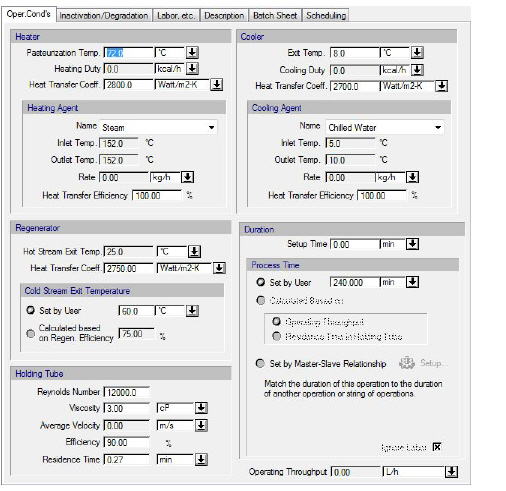

The following table shows a brief description of the variables appearing in this tab. The table also displays their default values and their generally acceptable range:
|
Variable |
Default Value |
Range |
|
|
||
|
○ Pasteurization Temp. (°C) |
72 |
Positive |
|
○ Heat Transfer Coefficient (Watt/(m2-K)) |
2800 |
Positive |
|
● Heating Duty (kcal/h) |
0.0 |
Positive |
|
○ Heating Agent Name |
<Steam> |
Any Heating Agent |
|
● Heating Agent In Temp. (oC) |
152.0 |
Positive |
|
● Heating Agent Out Temp. (oC) |
152.0 |
Positive |
|
● Heating Agent Rate (kg/h) |
0.0 |
Positive |
|
○ Heat Transfer Efficiency(%) |
100.0 |
[0,100) |
|
○ Exit Temp. (oC) |
8 |
Positive |
|
○ Heat Transfer Coefficient (Watt/(m2-K)) |
2700 |
Positive |
|
● Cooling Duty (kcal/h) |
0.0 |
Positive |
|
○ Cooling Agent Name |
<Chilled Water> |
Any Cooling Agent |
|
● Cooling Agent In Temp. (oC) |
5.0 |
Positive |
|
● Cooling Agent Out Temp. (oC) |
10.0 |
Positive |
|
● Cooling Agent Rate (kg/h) |
0.0 |
Positive |
|
● Operating Throughput (m3/h) |
0.0 |
Positive |
|
○ Setup Time (min) |
0.0 |
Positive |
|
◙ Process Time (min) |
240.0 |
Positive |
|
○ Ignore Labor? |
Yes |
Yes/No |
|
◙ Reynolds Number |
12,000.0 |
Positive |
|
○ Fluid Viscosity (cP) |
3.0 |
Positive |
|
● Average Velocity (m/s) |
0.0 |
Positive |
|
○ Efficiency |
90% |
0 - 99% |
|
◙ Residence Time (min) |
0.27 |
Positive |
|
○ Heat Transfer Coefficient (Watt/(m2-K)) |
2.48 |
Positive |
|
● Hot Stream exit Temp. (oC) |
25.0 |
Positive |
|
◙ Cold Stream exit Temp. (oC) |
60.0 |
Positive |
|
◙ Regenerator Efficiency |
75% |
0 - 99% |
Symbol Key: ○ User-specified value (always input); ● Calculated value (always output); ◙ Sometimes input, sometimes output
In Design mode the model calculates the heat transfer areas of the heat exchangers and the volume of the holding tube. In Rating Mode, the Reynolds number and residence time in the holding tube are calculated by the model. For more details, see Pasteurization: Modeling Calculations.
•Duration Options...
In Design mode the user must specify the process time or match the duration of this operation to the duration of another operation by introducing a master-slave relationship. If you introduce a master-slave relationship, the program will match the setup time, the process time and the turnaround time of this operation (the ‘slave’) with the corresponding times of the reference operation (the ‘master’ operation). For more details on how to setup a master-slave relationship, see The Scheduling Tab. In Rating Mode, the process time can either be specified or calculated based on the Throughput or the required Residence Time in the Holding Tube.